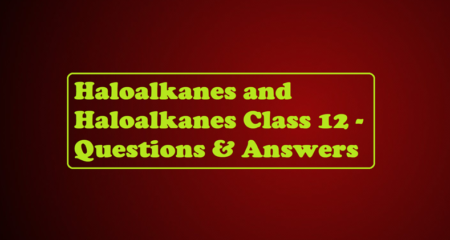Aldehydes and Ketones Questions and Answer
Aldehydes and Ketones Questions and Answer
Que 1. What product is formed when CH3COOH reacts with PCl5?
Ans 1. CH3COOH + PCl5→ CH3COCl + POCl3 + HCl
Que 2. How are formalin and trioxane related to methanal?
Ans 2. Formalin is a 40% aqueous solution of HCHO and trioxane is a trimer of HCHO.
Que 3. Arrange the following compounds in increasing order of their reactivity of nucleophilic addition reactions, ethanal, propanal, propanone, butanone.
Ans 3. Butanone < Propanone < Propanal < ethanol
Que 4. Although aldehydes are easily oxidizable yet propanal can conveniently be prepared by oxidation of propanol by acidic K2Cr2O7.
Ans 4. The aldehydes can be conveniently oxidized to their respective acids only if they are not removed from the reaction mixture during preparation. As the b.p. of propanal is low (323 K) it is conveniently distilled out during the reaction. This avoids further oxidation.
Que 5. How can we distinguish formic acid and acetic acid chemically?
Ans 5. Formic acid gives silver mirror with Tollen’s reagent while acetic acid does not give this test.
Que 6. Why is there a large difference in the boiling points of butanal and butan-1-ol?
Ans 6. Butan-1-ol has a higher boiling point due to intermolecular hydrogen bonding.
Que 7. Write a test to differentiate between pentan-2-one and pentan-3-one.
Ans 7. Iodoform test: Pentan-2-one gives yellow precipitate on reaction with NaOH and I2.
Que 8. Although phenoxide ion has more no. of resonating structures than carboxylate ion, even though carboxylic acid is a stronger acid why?
Ans 8. The phenoxide ion has non-equivalent resonance structures in which the –ve charge is at less electronegative C atom and the +ve charge is at more electronegative O-atom. In carboxylate ion –ve charge is delocalized on two electronegative O-atoms hence resonance is more effective.

Que 9. Why do Carboxylic acids have a higher boiling point than alcohols as alcohol forms the strongest inter molecular hydrogen bonding?
Ans 9. As Carboxylic acid forms a dimer due to which its surface area increases and forms strong intermolecular H-bonding- It has more boiling point than alcohols.
Que 10. What type of aldehydes undergoes the Cannizzaro reaction?
Ans 10. Aldehydes that do not contain α-hydrogen atoms undergo Cannizzaro reactions e.g. Formaldehyde (HCHO) and Benzaldehyde (C6H5CHO).
Que 11. Name the electrophile produced in the reaction of benzene with benzoyl chloride in the presence of anhydrous AlCl3. Name the reaction also.
Ans 11. Benzoylium cation or Friedel Craft’s acylation reaction.
Que 12. Give chemical tests to distinguish between the following pairs of compounds:
(i) Propanoyl chloride and propanoic acid
(ii) Benzaldehyde and acetophenone
Ans 12. (i) Propanoyl chloride does not give brisk effervescence with NaHCO3(aq) but propanoic acid does so.
(ii) Acetophenone gives yellow ppt of iodoform with I2 and NaOH whereas benzaldehyde does not show this reaction.
Que 13. What is Tollen’s reagent? Write one use of this reagent.
Ans 13. Tollen’s reagent is the ammoniacal solution of silver nitrate, [Ag(NH3)2]OH. Both aliphatic and aromatic aldehydes reduce Tollen’s reagent to metallic silver as a mirror.
Que 14. Explain why dimethyl cadmium is preferably used in the preparation of ketones from acid chlorides. In what respect it is better than RMgX?
Ans 14. Dimethyl cadmium is less reactive than Grignard’s reagent because it contains fewer electropositive cadmium atoms (E.N. =1.7) as compared to magnesium (E.N. = 1.2). Thus, dimethyl cadmium reacts with acid chloride to produce ketones. It does not react further. On the contrary when RMgX is used it reacts further with ketones to form tert alcohols.
Que 15. Arrange the following carbonyl compounds in increasing order of their reactivity in nucleophilic addition reactions:
(a) Ethanal, propanal, propanone, butanone
(b) Benzaldehyde, p-tolualdehyde, p-nitrobenzaldehyde, acetophenone.
Ans 15. (a) butanone< propanone < propanal < Ethanal.
(b) acetophenone < p-tolualdehyde < Benzaldehyde < p-nitrobenzaldehyde.
Aldehydes and Ketones Questions and Answer



